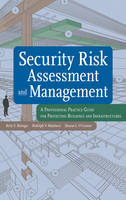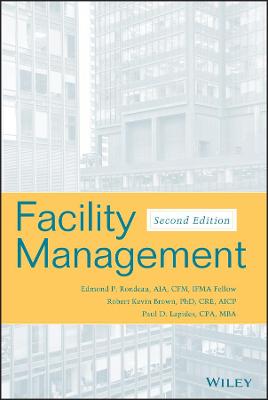Security Risk Assessment and Management
 -15%
portes grátis
-15%
portes grátis
Security Risk Assessment and Management
A Professional Practice Guide for Protecting Buildings and Infrastructures
Matalucci, Rudolph V.; Biringer, Betty E.; O'Connor, Sharon L.
John Wiley & Sons Inc
03/2007
384
Dura
Inglês
9780471793526
15 a 20 dias
746
Descrição não disponível.
Figures xv
Tables xix
Preface xxi
Acknowledgments xxv
Part I 1
1 Security Risk Assessment and Management Process 3
1.1 Introduction 3
1.2 Security Risk Equation 6
1.3 Security Risk Assessment and Management Process 8
1.3.1 Facility Characterization 9
1.3.2 Threat Analysis 10
1.3.3 Consequence Analysis 11
1.3.4 System Effectiveness Assessment 13
1.3.5 Risk Estimation 16
1.3.6 Comparison of Estimated Risk Levels 17
1.3.7 Risk Reduction Strategies 17
1.4 Presentation to Management 18
1.5 Risk Management Decisions 18
1.6 Information Protection 19
1.7 Process Summary 19
1.8 References 20
1.9 Exercises 21
2 Screening Analysis 23
2.1 Introduction 23
2.2 Screening Analysis Methods 23
2.3 Summary 30
2.4 References 30
2.5 Exercises 30
3 Facility Characterization 31
3.1 Introduction 31
3.2 Undesired Events 32
3.3 Facility Description 33
3.3.1 Physical Details 33
3.3.2 Cyber-Information System 34
3.3.3 Facility Operations 34
3.3.4 Security Protection Systems 35
3.3.5 Workforce Description 38
3.3.6 Restrictions, Requirements, Limitations 39
3.4 Critical Assets 40
3.4.1 Generic Fault Tree 40
3.4.2 Identifying Critical Assets 42
3.5 Protection Objectives 44
3.6 Summary 45
3.7 References 46
3.8 Exercises 46
4 Threat Analysis 49
4.1 Introduction 49
4.2 Sources of Threat Information 50
4.2.1 Local and State Sources 51
4.2.2 National Sources 52
4.3 Adversary Spectrum 53
4.4 Adversary Capability 56
4.5 Threat Potential for Attack 58
4.5.1 Outsider Threat 62
4.5.2 Insider Threat 69
4.6 Summary 71
4.7 References 71
4.8 Exercises 72
5 Consequence Analysis 75
5.1 Introduction 75
5.2 Reference Table of Consequences 75
5.3 Consequence Values for Undesired Events 77
5.4 Summary 81
5.5 References 81
5.6 Exercises 81
6 Asset Prioritization 83
6.1 Introduction 83
6.2 Prioritization Matrix 84
6.3 Summary 85
6.4 References 85
6.5 Exercises 86
7 System Effectiveness 87
7.1 Introduction 87
7.2 Protection System Effectiveness 88
7.2.1 Adversary Strategies 88
7.2.2 Physical Protection System Effectiveness 90
7.2.3 Cyber-Protection System Effectiveness 106
7.3 Summary 116
7.4 References 117
7.5 Exercises 118
8 Estimating Security Risk 121
8.1 Introduction 121
8.2 Estimating Security Risk 121
8.2.1 Conditional Risk 122
8.2.2 Relative Risk 122
8.3 Summary 125
8.4 References 125
8.5 Exercises 125
9 Risk Reduction Strategies 127
9.1 Introduction 127
9.2 Strategies for Reducing Likelihood of Attack 127
9.3 Strategies for Increasing Protection System Effectiveness 129
9.3.1 Physical Protection System Upgrades 129
9.3.2 Cyber-Protection System Upgrades 129
9.3.3 Protection System Upgrade Package(s) 129
9.4 Strategies for Mitigating Consequences 132
9.4.1 Construction Hardening 133
9.4.2 Redundancy 141
9.4.3 Optimized Recovery Strategies 143
9.4.4 Emergency Planning 145
9.5 Combinations of Reduction Strategies 148
9.6 Summary 149
9.7 References 150
9.8 Exercises 151
10 Evaluating Impacts 153
10.1 Risk Level 153
10.2 Costs 157
10.3 Operations/Schedules 159
10.4 Public Opinion 160
10.5 Other Site-Specific Concerns 160
10.6 Review Threat Analysis 161
10.7 Summary 162
10.8 References 162
10.9 Exercises 163
11 Risk Management Decisions 165
11.1 Introduction 165
11.2 Risk Assessment Results 166
11.2.1 Executive Summary 167
11.2.2 Introduction 167
11.2.3 Threat Analysis 168
11.2.4 Consequence Analysis 168
11.2.5 System Effectiveness Assessment 169
11.2.6 Risk Estimation 169
11.2.7 Risk Reduction Strategies and Packages 170
11.2.8 Impact Analysis 170
11.2.9 Supporting Documentation 171
11.2.10 Report Overview 171
11.3 Risk Management Decisions 171
11.4 Establish Design Threat 173
11.5 Summary 174
11.6 References 174
11.7 Exercises 174
12 Summary 175
12.1 Facility Characterization 177
12.2 Threat Analysis 178
12.3 Consequence Analysis 180
12.4 System Effectiveness Assessment 180
12.5 Risk Estimation 182
12.6 Comparison of Estimated Risk Level to Threshold 183
12.7 Risk Reduction Strategies 183
12.8 Analysis of Impacts Imposed by Risk Reduction Upgrade Packages 184
12.9 Presentation to Management 185
12.10 Risk Management Decisions 185
Part II 187
13 Demonstration of the Security Risk Assessment and Management Process 189
13.1 Introduction 189
13.2 Security Risk Assessment and Management Process 190
13.3 Screening Analysis 192
13.4 Facility Characterization 195
13.5 Operations 196
13.6 General Description 198
13.7 Threat 214
13.8 Consequences 228
13.9 Prioritization Analysis 238
13.10 Protection System Effectiveness 243
13.10.1 Physical Protection System Effectiveness 245
13.10.2 Analysis of Blast Effects 264
13.11 Estimation of Risk 269
13.11.1 Risk Summary 269
13.12 Risk Reduction Strategies 272
13.12.1 Physical Protection System Upgrades 273
13.12.2 Result of Physical Protection System Upgrades 276
13.12.3 Cyber-Protection System Upgrades 280
13.12.4 Results of Cyber-Protection System Upgrades 281
13.12.5 Consequence Mitigation Upgrades 281
13.12.6 Summary 284
13.13 Impact Analysis 285
13.13.1 Impacts of Upgrade Package 285
13.13.2 Impacts of Consequence Mitigation Package 288
13.14 Presentation to Management 288
13.14.1 Threat Description 289
13.14.2 Security Risk Estimates for the Baseline System 289
13.14.3 Risk Reduction Packages 290
13.14.4 Impact Analysis for Risk Reduction Package 294
13.15 Risk Management Decisions 295
Appendix A: Generic Fault Tree for Buildings 297
Appendix B: Adversary Sequence Diagrams 303
Appendix C: Physical System Effectiveness Worksheets 309
Appendix D: Insider Threat 329
Acronyms 345
Glossary 347
Index 353
Tables xix
Preface xxi
Acknowledgments xxv
Part I 1
1 Security Risk Assessment and Management Process 3
1.1 Introduction 3
1.2 Security Risk Equation 6
1.3 Security Risk Assessment and Management Process 8
1.3.1 Facility Characterization 9
1.3.2 Threat Analysis 10
1.3.3 Consequence Analysis 11
1.3.4 System Effectiveness Assessment 13
1.3.5 Risk Estimation 16
1.3.6 Comparison of Estimated Risk Levels 17
1.3.7 Risk Reduction Strategies 17
1.4 Presentation to Management 18
1.5 Risk Management Decisions 18
1.6 Information Protection 19
1.7 Process Summary 19
1.8 References 20
1.9 Exercises 21
2 Screening Analysis 23
2.1 Introduction 23
2.2 Screening Analysis Methods 23
2.3 Summary 30
2.4 References 30
2.5 Exercises 30
3 Facility Characterization 31
3.1 Introduction 31
3.2 Undesired Events 32
3.3 Facility Description 33
3.3.1 Physical Details 33
3.3.2 Cyber-Information System 34
3.3.3 Facility Operations 34
3.3.4 Security Protection Systems 35
3.3.5 Workforce Description 38
3.3.6 Restrictions, Requirements, Limitations 39
3.4 Critical Assets 40
3.4.1 Generic Fault Tree 40
3.4.2 Identifying Critical Assets 42
3.5 Protection Objectives 44
3.6 Summary 45
3.7 References 46
3.8 Exercises 46
4 Threat Analysis 49
4.1 Introduction 49
4.2 Sources of Threat Information 50
4.2.1 Local and State Sources 51
4.2.2 National Sources 52
4.3 Adversary Spectrum 53
4.4 Adversary Capability 56
4.5 Threat Potential for Attack 58
4.5.1 Outsider Threat 62
4.5.2 Insider Threat 69
4.6 Summary 71
4.7 References 71
4.8 Exercises 72
5 Consequence Analysis 75
5.1 Introduction 75
5.2 Reference Table of Consequences 75
5.3 Consequence Values for Undesired Events 77
5.4 Summary 81
5.5 References 81
5.6 Exercises 81
6 Asset Prioritization 83
6.1 Introduction 83
6.2 Prioritization Matrix 84
6.3 Summary 85
6.4 References 85
6.5 Exercises 86
7 System Effectiveness 87
7.1 Introduction 87
7.2 Protection System Effectiveness 88
7.2.1 Adversary Strategies 88
7.2.2 Physical Protection System Effectiveness 90
7.2.3 Cyber-Protection System Effectiveness 106
7.3 Summary 116
7.4 References 117
7.5 Exercises 118
8 Estimating Security Risk 121
8.1 Introduction 121
8.2 Estimating Security Risk 121
8.2.1 Conditional Risk 122
8.2.2 Relative Risk 122
8.3 Summary 125
8.4 References 125
8.5 Exercises 125
9 Risk Reduction Strategies 127
9.1 Introduction 127
9.2 Strategies for Reducing Likelihood of Attack 127
9.3 Strategies for Increasing Protection System Effectiveness 129
9.3.1 Physical Protection System Upgrades 129
9.3.2 Cyber-Protection System Upgrades 129
9.3.3 Protection System Upgrade Package(s) 129
9.4 Strategies for Mitigating Consequences 132
9.4.1 Construction Hardening 133
9.4.2 Redundancy 141
9.4.3 Optimized Recovery Strategies 143
9.4.4 Emergency Planning 145
9.5 Combinations of Reduction Strategies 148
9.6 Summary 149
9.7 References 150
9.8 Exercises 151
10 Evaluating Impacts 153
10.1 Risk Level 153
10.2 Costs 157
10.3 Operations/Schedules 159
10.4 Public Opinion 160
10.5 Other Site-Specific Concerns 160
10.6 Review Threat Analysis 161
10.7 Summary 162
10.8 References 162
10.9 Exercises 163
11 Risk Management Decisions 165
11.1 Introduction 165
11.2 Risk Assessment Results 166
11.2.1 Executive Summary 167
11.2.2 Introduction 167
11.2.3 Threat Analysis 168
11.2.4 Consequence Analysis 168
11.2.5 System Effectiveness Assessment 169
11.2.6 Risk Estimation 169
11.2.7 Risk Reduction Strategies and Packages 170
11.2.8 Impact Analysis 170
11.2.9 Supporting Documentation 171
11.2.10 Report Overview 171
11.3 Risk Management Decisions 171
11.4 Establish Design Threat 173
11.5 Summary 174
11.6 References 174
11.7 Exercises 174
12 Summary 175
12.1 Facility Characterization 177
12.2 Threat Analysis 178
12.3 Consequence Analysis 180
12.4 System Effectiveness Assessment 180
12.5 Risk Estimation 182
12.6 Comparison of Estimated Risk Level to Threshold 183
12.7 Risk Reduction Strategies 183
12.8 Analysis of Impacts Imposed by Risk Reduction Upgrade Packages 184
12.9 Presentation to Management 185
12.10 Risk Management Decisions 185
Part II 187
13 Demonstration of the Security Risk Assessment and Management Process 189
13.1 Introduction 189
13.2 Security Risk Assessment and Management Process 190
13.3 Screening Analysis 192
13.4 Facility Characterization 195
13.5 Operations 196
13.6 General Description 198
13.7 Threat 214
13.8 Consequences 228
13.9 Prioritization Analysis 238
13.10 Protection System Effectiveness 243
13.10.1 Physical Protection System Effectiveness 245
13.10.2 Analysis of Blast Effects 264
13.11 Estimation of Risk 269
13.11.1 Risk Summary 269
13.12 Risk Reduction Strategies 272
13.12.1 Physical Protection System Upgrades 273
13.12.2 Result of Physical Protection System Upgrades 276
13.12.3 Cyber-Protection System Upgrades 280
13.12.4 Results of Cyber-Protection System Upgrades 281
13.12.5 Consequence Mitigation Upgrades 281
13.12.6 Summary 284
13.13 Impact Analysis 285
13.13.1 Impacts of Upgrade Package 285
13.13.2 Impacts of Consequence Mitigation Package 288
13.14 Presentation to Management 288
13.14.1 Threat Description 289
13.14.2 Security Risk Estimates for the Baseline System 289
13.14.3 Risk Reduction Packages 290
13.14.4 Impact Analysis for Risk Reduction Package 294
13.15 Risk Management Decisions 295
Appendix A: Generic Fault Tree for Buildings 297
Appendix B: Adversary Sequence Diagrams 303
Appendix C: Physical System Effectiveness Worksheets 309
Appendix D: Insider Threat 329
Acronyms 345
Glossary 347
Index 353
Este título pertence ao(s) assunto(s) indicados(s). Para ver outros títulos clique no assunto desejado.
management of buildings, infrastructures, security, workplace environments, Sandia National Laboratories,regional and site-specific threats
Figures xv
Tables xix
Preface xxi
Acknowledgments xxv
Part I 1
1 Security Risk Assessment and Management Process 3
1.1 Introduction 3
1.2 Security Risk Equation 6
1.3 Security Risk Assessment and Management Process 8
1.3.1 Facility Characterization 9
1.3.2 Threat Analysis 10
1.3.3 Consequence Analysis 11
1.3.4 System Effectiveness Assessment 13
1.3.5 Risk Estimation 16
1.3.6 Comparison of Estimated Risk Levels 17
1.3.7 Risk Reduction Strategies 17
1.4 Presentation to Management 18
1.5 Risk Management Decisions 18
1.6 Information Protection 19
1.7 Process Summary 19
1.8 References 20
1.9 Exercises 21
2 Screening Analysis 23
2.1 Introduction 23
2.2 Screening Analysis Methods 23
2.3 Summary 30
2.4 References 30
2.5 Exercises 30
3 Facility Characterization 31
3.1 Introduction 31
3.2 Undesired Events 32
3.3 Facility Description 33
3.3.1 Physical Details 33
3.3.2 Cyber-Information System 34
3.3.3 Facility Operations 34
3.3.4 Security Protection Systems 35
3.3.5 Workforce Description 38
3.3.6 Restrictions, Requirements, Limitations 39
3.4 Critical Assets 40
3.4.1 Generic Fault Tree 40
3.4.2 Identifying Critical Assets 42
3.5 Protection Objectives 44
3.6 Summary 45
3.7 References 46
3.8 Exercises 46
4 Threat Analysis 49
4.1 Introduction 49
4.2 Sources of Threat Information 50
4.2.1 Local and State Sources 51
4.2.2 National Sources 52
4.3 Adversary Spectrum 53
4.4 Adversary Capability 56
4.5 Threat Potential for Attack 58
4.5.1 Outsider Threat 62
4.5.2 Insider Threat 69
4.6 Summary 71
4.7 References 71
4.8 Exercises 72
5 Consequence Analysis 75
5.1 Introduction 75
5.2 Reference Table of Consequences 75
5.3 Consequence Values for Undesired Events 77
5.4 Summary 81
5.5 References 81
5.6 Exercises 81
6 Asset Prioritization 83
6.1 Introduction 83
6.2 Prioritization Matrix 84
6.3 Summary 85
6.4 References 85
6.5 Exercises 86
7 System Effectiveness 87
7.1 Introduction 87
7.2 Protection System Effectiveness 88
7.2.1 Adversary Strategies 88
7.2.2 Physical Protection System Effectiveness 90
7.2.3 Cyber-Protection System Effectiveness 106
7.3 Summary 116
7.4 References 117
7.5 Exercises 118
8 Estimating Security Risk 121
8.1 Introduction 121
8.2 Estimating Security Risk 121
8.2.1 Conditional Risk 122
8.2.2 Relative Risk 122
8.3 Summary 125
8.4 References 125
8.5 Exercises 125
9 Risk Reduction Strategies 127
9.1 Introduction 127
9.2 Strategies for Reducing Likelihood of Attack 127
9.3 Strategies for Increasing Protection System Effectiveness 129
9.3.1 Physical Protection System Upgrades 129
9.3.2 Cyber-Protection System Upgrades 129
9.3.3 Protection System Upgrade Package(s) 129
9.4 Strategies for Mitigating Consequences 132
9.4.1 Construction Hardening 133
9.4.2 Redundancy 141
9.4.3 Optimized Recovery Strategies 143
9.4.4 Emergency Planning 145
9.5 Combinations of Reduction Strategies 148
9.6 Summary 149
9.7 References 150
9.8 Exercises 151
10 Evaluating Impacts 153
10.1 Risk Level 153
10.2 Costs 157
10.3 Operations/Schedules 159
10.4 Public Opinion 160
10.5 Other Site-Specific Concerns 160
10.6 Review Threat Analysis 161
10.7 Summary 162
10.8 References 162
10.9 Exercises 163
11 Risk Management Decisions 165
11.1 Introduction 165
11.2 Risk Assessment Results 166
11.2.1 Executive Summary 167
11.2.2 Introduction 167
11.2.3 Threat Analysis 168
11.2.4 Consequence Analysis 168
11.2.5 System Effectiveness Assessment 169
11.2.6 Risk Estimation 169
11.2.7 Risk Reduction Strategies and Packages 170
11.2.8 Impact Analysis 170
11.2.9 Supporting Documentation 171
11.2.10 Report Overview 171
11.3 Risk Management Decisions 171
11.4 Establish Design Threat 173
11.5 Summary 174
11.6 References 174
11.7 Exercises 174
12 Summary 175
12.1 Facility Characterization 177
12.2 Threat Analysis 178
12.3 Consequence Analysis 180
12.4 System Effectiveness Assessment 180
12.5 Risk Estimation 182
12.6 Comparison of Estimated Risk Level to Threshold 183
12.7 Risk Reduction Strategies 183
12.8 Analysis of Impacts Imposed by Risk Reduction Upgrade Packages 184
12.9 Presentation to Management 185
12.10 Risk Management Decisions 185
Part II 187
13 Demonstration of the Security Risk Assessment and Management Process 189
13.1 Introduction 189
13.2 Security Risk Assessment and Management Process 190
13.3 Screening Analysis 192
13.4 Facility Characterization 195
13.5 Operations 196
13.6 General Description 198
13.7 Threat 214
13.8 Consequences 228
13.9 Prioritization Analysis 238
13.10 Protection System Effectiveness 243
13.10.1 Physical Protection System Effectiveness 245
13.10.2 Analysis of Blast Effects 264
13.11 Estimation of Risk 269
13.11.1 Risk Summary 269
13.12 Risk Reduction Strategies 272
13.12.1 Physical Protection System Upgrades 273
13.12.2 Result of Physical Protection System Upgrades 276
13.12.3 Cyber-Protection System Upgrades 280
13.12.4 Results of Cyber-Protection System Upgrades 281
13.12.5 Consequence Mitigation Upgrades 281
13.12.6 Summary 284
13.13 Impact Analysis 285
13.13.1 Impacts of Upgrade Package 285
13.13.2 Impacts of Consequence Mitigation Package 288
13.14 Presentation to Management 288
13.14.1 Threat Description 289
13.14.2 Security Risk Estimates for the Baseline System 289
13.14.3 Risk Reduction Packages 290
13.14.4 Impact Analysis for Risk Reduction Package 294
13.15 Risk Management Decisions 295
Appendix A: Generic Fault Tree for Buildings 297
Appendix B: Adversary Sequence Diagrams 303
Appendix C: Physical System Effectiveness Worksheets 309
Appendix D: Insider Threat 329
Acronyms 345
Glossary 347
Index 353
Tables xix
Preface xxi
Acknowledgments xxv
Part I 1
1 Security Risk Assessment and Management Process 3
1.1 Introduction 3
1.2 Security Risk Equation 6
1.3 Security Risk Assessment and Management Process 8
1.3.1 Facility Characterization 9
1.3.2 Threat Analysis 10
1.3.3 Consequence Analysis 11
1.3.4 System Effectiveness Assessment 13
1.3.5 Risk Estimation 16
1.3.6 Comparison of Estimated Risk Levels 17
1.3.7 Risk Reduction Strategies 17
1.4 Presentation to Management 18
1.5 Risk Management Decisions 18
1.6 Information Protection 19
1.7 Process Summary 19
1.8 References 20
1.9 Exercises 21
2 Screening Analysis 23
2.1 Introduction 23
2.2 Screening Analysis Methods 23
2.3 Summary 30
2.4 References 30
2.5 Exercises 30
3 Facility Characterization 31
3.1 Introduction 31
3.2 Undesired Events 32
3.3 Facility Description 33
3.3.1 Physical Details 33
3.3.2 Cyber-Information System 34
3.3.3 Facility Operations 34
3.3.4 Security Protection Systems 35
3.3.5 Workforce Description 38
3.3.6 Restrictions, Requirements, Limitations 39
3.4 Critical Assets 40
3.4.1 Generic Fault Tree 40
3.4.2 Identifying Critical Assets 42
3.5 Protection Objectives 44
3.6 Summary 45
3.7 References 46
3.8 Exercises 46
4 Threat Analysis 49
4.1 Introduction 49
4.2 Sources of Threat Information 50
4.2.1 Local and State Sources 51
4.2.2 National Sources 52
4.3 Adversary Spectrum 53
4.4 Adversary Capability 56
4.5 Threat Potential for Attack 58
4.5.1 Outsider Threat 62
4.5.2 Insider Threat 69
4.6 Summary 71
4.7 References 71
4.8 Exercises 72
5 Consequence Analysis 75
5.1 Introduction 75
5.2 Reference Table of Consequences 75
5.3 Consequence Values for Undesired Events 77
5.4 Summary 81
5.5 References 81
5.6 Exercises 81
6 Asset Prioritization 83
6.1 Introduction 83
6.2 Prioritization Matrix 84
6.3 Summary 85
6.4 References 85
6.5 Exercises 86
7 System Effectiveness 87
7.1 Introduction 87
7.2 Protection System Effectiveness 88
7.2.1 Adversary Strategies 88
7.2.2 Physical Protection System Effectiveness 90
7.2.3 Cyber-Protection System Effectiveness 106
7.3 Summary 116
7.4 References 117
7.5 Exercises 118
8 Estimating Security Risk 121
8.1 Introduction 121
8.2 Estimating Security Risk 121
8.2.1 Conditional Risk 122
8.2.2 Relative Risk 122
8.3 Summary 125
8.4 References 125
8.5 Exercises 125
9 Risk Reduction Strategies 127
9.1 Introduction 127
9.2 Strategies for Reducing Likelihood of Attack 127
9.3 Strategies for Increasing Protection System Effectiveness 129
9.3.1 Physical Protection System Upgrades 129
9.3.2 Cyber-Protection System Upgrades 129
9.3.3 Protection System Upgrade Package(s) 129
9.4 Strategies for Mitigating Consequences 132
9.4.1 Construction Hardening 133
9.4.2 Redundancy 141
9.4.3 Optimized Recovery Strategies 143
9.4.4 Emergency Planning 145
9.5 Combinations of Reduction Strategies 148
9.6 Summary 149
9.7 References 150
9.8 Exercises 151
10 Evaluating Impacts 153
10.1 Risk Level 153
10.2 Costs 157
10.3 Operations/Schedules 159
10.4 Public Opinion 160
10.5 Other Site-Specific Concerns 160
10.6 Review Threat Analysis 161
10.7 Summary 162
10.8 References 162
10.9 Exercises 163
11 Risk Management Decisions 165
11.1 Introduction 165
11.2 Risk Assessment Results 166
11.2.1 Executive Summary 167
11.2.2 Introduction 167
11.2.3 Threat Analysis 168
11.2.4 Consequence Analysis 168
11.2.5 System Effectiveness Assessment 169
11.2.6 Risk Estimation 169
11.2.7 Risk Reduction Strategies and Packages 170
11.2.8 Impact Analysis 170
11.2.9 Supporting Documentation 171
11.2.10 Report Overview 171
11.3 Risk Management Decisions 171
11.4 Establish Design Threat 173
11.5 Summary 174
11.6 References 174
11.7 Exercises 174
12 Summary 175
12.1 Facility Characterization 177
12.2 Threat Analysis 178
12.3 Consequence Analysis 180
12.4 System Effectiveness Assessment 180
12.5 Risk Estimation 182
12.6 Comparison of Estimated Risk Level to Threshold 183
12.7 Risk Reduction Strategies 183
12.8 Analysis of Impacts Imposed by Risk Reduction Upgrade Packages 184
12.9 Presentation to Management 185
12.10 Risk Management Decisions 185
Part II 187
13 Demonstration of the Security Risk Assessment and Management Process 189
13.1 Introduction 189
13.2 Security Risk Assessment and Management Process 190
13.3 Screening Analysis 192
13.4 Facility Characterization 195
13.5 Operations 196
13.6 General Description 198
13.7 Threat 214
13.8 Consequences 228
13.9 Prioritization Analysis 238
13.10 Protection System Effectiveness 243
13.10.1 Physical Protection System Effectiveness 245
13.10.2 Analysis of Blast Effects 264
13.11 Estimation of Risk 269
13.11.1 Risk Summary 269
13.12 Risk Reduction Strategies 272
13.12.1 Physical Protection System Upgrades 273
13.12.2 Result of Physical Protection System Upgrades 276
13.12.3 Cyber-Protection System Upgrades 280
13.12.4 Results of Cyber-Protection System Upgrades 281
13.12.5 Consequence Mitigation Upgrades 281
13.12.6 Summary 284
13.13 Impact Analysis 285
13.13.1 Impacts of Upgrade Package 285
13.13.2 Impacts of Consequence Mitigation Package 288
13.14 Presentation to Management 288
13.14.1 Threat Description 289
13.14.2 Security Risk Estimates for the Baseline System 289
13.14.3 Risk Reduction Packages 290
13.14.4 Impact Analysis for Risk Reduction Package 294
13.15 Risk Management Decisions 295
Appendix A: Generic Fault Tree for Buildings 297
Appendix B: Adversary Sequence Diagrams 303
Appendix C: Physical System Effectiveness Worksheets 309
Appendix D: Insider Threat 329
Acronyms 345
Glossary 347
Index 353
Este título pertence ao(s) assunto(s) indicados(s). Para ver outros títulos clique no assunto desejado.




